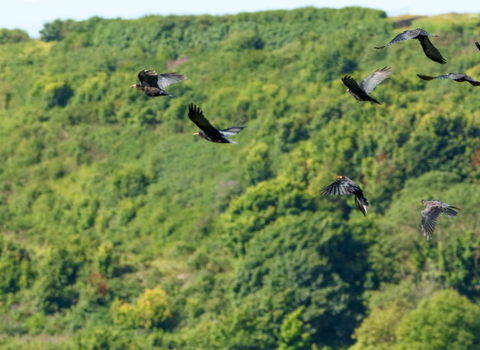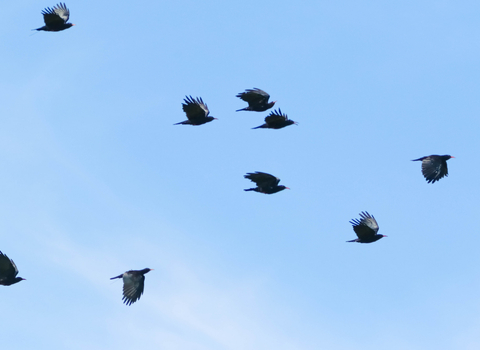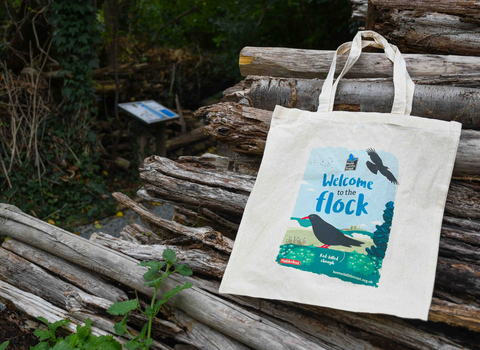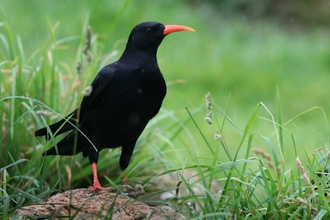In July 2023, as a result of four decades of chalk grassland restoration, these charismatic birds are emerging from our history books and legends. They have returned to our skies, thanks to a partnership between Kent Wildlife Trust, Wildwood Trust and Paradise Park Cornwall.
As of summer 2024, there are clear signs that the once-extinct red-billed chough will thrive again in the South East. Less than a year on from their release, and following the emergence of a breeding pair, the first wild chick for generations was hatched at Dover Castle. The chick fledged successfully in June but unfortunately went missing during strong winds and hasn’t been seen since early July. Still, the birth is a milestone we didn’t expect to hit so early by any means.
Paul Hadaway, Director of Conservation & Engagement at Kent Wildlife Trust says: “The red-billed chough reintroduction project in Dover demonstrates that, even with the perilous state of nature and wildlife in this country it is still possible to restore nature and return missing species.
The project is rooted in strong science and feasibility work and several decades of concerted habitat restoration. We have laid the foundations for a successful release program that will see this flagship bird reestablished in a county with which it has a long cultural association.”
Liz Corry is the Chough Release Supervisor for Wildwood Trust says: “The birth of the first wild chick was a milestone we didn’t expect to hit so early. The parents are young themselves but successfully built a nest and incubated the chick, which is a huge achievement.
A sudden change in the weather led to very strong winds at Dover and we lost sight of the chick. This is the reality of working in the wild with Mother Nature and we know other breeding species have also been affected this season.
There will be ups and downs in this project, which is why we need to keep the releases going and grow the population, with the hope that they’ll start forming bonds and and pairs and continue to breed."
Choughs have been absent from the wild in Kent for over 200 years due to habitat loss and historical persecution. Yet, this species has retained a deep cultural link throughout Kent's history - these iconic birds can be spotted on pub signs across our county as well as on the Canterbury coat of arms itself.
For four decades, Kent Wildlife Trust has worked alongside others, including the National Trust, English Heritage and White Cliffs Countryside Partnership, to restore chalk grassland habitat and reintroduce conservation grazing management across East Kent. Extensive feasibility studies have shown that, thanks to this dedicated restoration work, there is now suitable habitat to support the return of wild red-billed choughs to Kent - and we couldn't be more delighted to welcome them back.
Thank you to everyone who has supported this reintroduction project so far, whether by visiting the chough aviary at Dover Castle, donating to our appeal or spreading the word about this project online and in your communities. We could not have done it without you. But the work is far from over and we still need your support to allow further releases and ensure the ongoing population keeps flying high in Kent. Every penny counts, will you be a Chough Champion?
FAQs
Why choughs?
The red-billed chough is a rare member of the crow family with glossy black plumage, red legs and a bright red beak. The chough was once native to Kent but became extinct here more than 200 years ago due to intensive farming practices and persecution.
The return of choughs will:
- demonstrate the incredible potential of conservation work to return missing species, paving the way for further habitat restoration across our county
- encourage farmers and landowners to reduce the use of worming and other treatments in livestock, thereby benefitting the whole ecosystem
- engage communities in conservation due to their cultural and historical significance to Kent
What do choughs eat?
Choughs are specialist soil and dung invertebrate feeders. In other words, they eat insects.
What is the ideal habitat for choughs?
Choughs favour short chalk grassland - a habitat which has declined significantly due to intensive farming resulting in the extinction of wild choughs in Kent.
For four decades, Kent Wildlife Trust has worked alongside others, including the National Trust and White Cliffs Countryside Partnership, to restore chalk grassland habitat and reintroduce conservation grazing management across East Kent.
Extensive feasibility studies have shown that, thanks to this dedicated restoration work, there is now enough suitable habitat to support the return of wild red-billed choughs to Kent - and we couldn't be more delighted to welcome them back.
What is conservation grazing?
Large herbivores once roamed our landscapes. Their grazing behaviours maintain key habitats (such as grassland and heathland) by controlling the spread of certain plant species and allowing many others to thrive.
In order to mimic this ancient activity, we have introduced grazing animals, such as sheep, cattle and ponies, as well as pigs, to many of our reserves. Their grazing and rooting behaviours help to naturally and effectively restore and maintain biodiversity. These animals also provide another service: their dung is home to a variety of invertebrates, all of which are eaten by choughs.
What about competition between bird species?
Chough used to be part of this landscape and evolved to coexist with other species such as ravens and peregrines. Although they may compete for some resources such as nest sites, we will monitor this and provide additional nesting opportunities if required.
As a specialist soil and dung invertebrate feeder, choughs are unlikely to outcompete any other species. There are no other species sharing the short grassland habitat which rely solely on soil and dung invertebrates.
What cultural links do choughs have to Kent?
Many will know the story of the murder of Thomas Becket. The year 2020 marked 850 years since his dramatic murder, but you may be less familiar with a mythical connection to the chough.
It is rumoured that as Thomas Becket lay dying, a crow flew down, paddled in his blood and acquired a startling red beak and feet, transforming into a chough.
Sometime after his death, Thomas was attributed a coat of arms featuring three choughs, which first appeared about 100 years later in Canterbury Cathedral, and, in the 14th century, the City of Canterbury adopted a coat of arms with three choughs and a royal lion.
The choughs’ connection to Dover was also immortalised by William Shakespeare who wrote of these charismatic birds in ‘King Lear’. He describes ‘the Crowes and Choughes that wing the midway ayre’, at what became known as ‘Shakespeare Cliff’.
What are the future plans for this project?
The project partnership will be releasing small family-sized cohorts of between 6-12 birds each year for a minimum of five years in order to establish a breeding population of 50 birds.
Corvid ID guide: how to spot a chough

Is the text too small?
Use the zoom function on your browser or click here to see a bigger version.
Watch our latest Chough Chats session below to find out more about this charismatic species and our reintroduction project:







